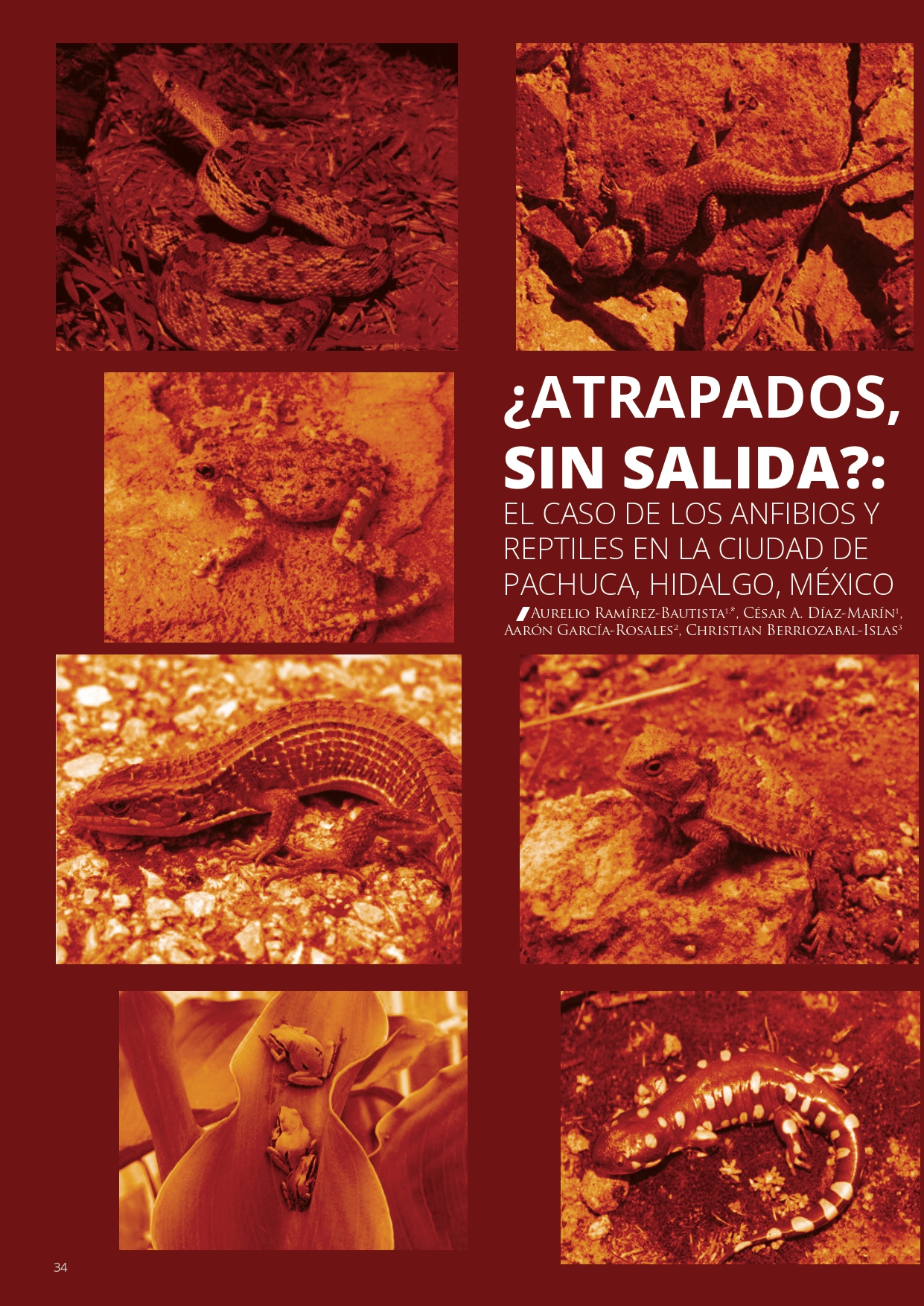¿Atrapados, sin salida?: El caso de los anfibios y reptiles en la ciudad de Pachuca, Hidalgo, México
Keywords:
Amphibians, reptiles, local extinction, anthropic effect, global warmingAbstract
The anthropic effect and global climate change are two of the main factors that negatively affect biodiversity worldwide. However, not all species are affected in the same way. For example, some species of amphibians and reptiles, despite facing certain adversities, continue inhabiting the city of Pachuca, Hidalgo, Mexico. The populations of both groups of vertebrates have been trapped and isolated in small patches within the city such as public parks, vacant lots, gardens, among others, which are increasingly reduced, resulting in the local extinction of some populations. Therefore, the purpose of this note is to generate a reflection on the species of amphibians and reptiles that were trapped and isolated in limited spaces within the City of Pachuca without having time and/or means of dispersion such as they are the biological corridors that connect these populations with others outside the city, thus hindering their survival and eroding (loss) the genetic diversity of populations.
Downloads
References
Berriozabal-Islas, C., J.F. Mota-Rodrigues, A. Ramírez-Bautista, J.L. Becerra-López, A. Nieto-Montes de Oca. 2018. Effect of climate change in lizards of the genus Xenosaurus (Xenosauridae) based on projected changes in climatic suitability and climatic niche conservatism. Ecology and Evolution. 8: 6860-6871. https://doi.org/10.1002/ece3.4200
Cosendey, B. N., Rocha C. F. D., Menezes, V. A. 2022. Climate change, lizard populations, and species vulnerability/persistence: trends in ecological and predictive climate studies. Environment, Development and Sustainability, 1-22.
Fuentes Y. 2022. Alista alcaldía de Pachuca crecimiento ordenado y sustentable del municipio. Periódico Síntesis digital. Consultado el 26 de noviembre de 2022 en https://sintesis.com.mx/hidalgo/2022/10/14/pachuca-crecimiento-ordenado/
Leyte-Manrique, A., U. Hernández-Salinas, A. Ramírez-Bautista, V. Mata-Silva, J.C. Marshall. 2017. Habitat use in eight populations of Sceloporus grammicus (Squamata: Phrynosomatidae) from Mexican Plateau. Integrative Zoology. 12: 198-210. https://doi.org/10.1111/1749-4877.12239
Liner, E. A., Casas-Andreu G. 2008. Nombres estándar en español, en inglés y nombres científicos de los anfibios y reptiles de México. Standard spanish, english and scientific names of the amphibians and reptiles of Mexico. Herpetological Circular (38). Society for the Study of Amphibians and Reptiles.
Magno-Benítez, I., A. Ramírez-Bautista, R. Cruz-Elizalde. 2016. Diversidad de especies de anfibios y reptiles en dos ambientes, natural y antropizado, en el estado de Hidalgo, México. Pp. 97-105. En: Ramírez-Bautista, A. & R. Pineda-López (Eds.). Fauna Nativa en Ambientes Antropizados. CONACYT-UAQ. Qurétaro, México, 237pp.
Ramírez-Bautista, A., U. Hernández-Salinas, U.O. García-Vázquez, A. Leyte-Manrique, L. Canseco-Márquez. 2009. Herpetofauna del Valle de México: Diversidad y Conservación. Universidad Autónoma del Estado de Hidalgo y Comisión Nacional para el Conocimiento y Uso de la Biodiversidad, México, 213 pp.
Ramírez-Bautista, A., U. Hernández-Salinas, R. Cruz-Elizalde, C. Berriozabal-Islas, D. Lara-Tufiño, I. Goyenechea Mayer-Goyenechea, J.M. Castillo-Cerón. 2014. Los anfibios y reptiles de Hidalgo, México: Diversidad, biogeografía y conservación. Sociedad Herpetológica Mexicana, A. C., México, 387 pp.
Ramírez-Bautista, A., U. Hernández Salinas, R. Cruz-Elizalde, C. Berriozabal-Islas, I. Moreno-Lara, D.L. DeSantis, J.D. Johnson, E. García-Padilla, V. Mata-Silva, L.D. Wilson. 2020. The herpetofauna of Hidalgo, Mexico: Composition, distribution, and conservation status. Amphibian and Reptile Conservation. 14 (1): 63-118.
Segar, J., C.T. Callaghan, E. Ladouceur, J.N. Meya, H.M. Pereira, A. Perino, I.R. Staude. 2022. Urban Conservation Gardening in the decade of restoration. Nature Sustainability. 5: 649-656. https://www.nature.com/articles/s41893-022-00882-z







